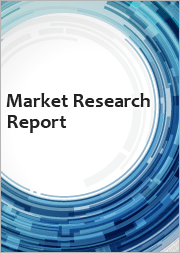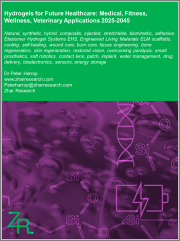
|
시장보고서
상품코드
1475837
세계의 하이드로겔 시장 규모 조사 및 예측 : 구조별, 재료별, 최종 사용자 산업별, 지역별 분석(2023-2030년)Global Hydrogel Market Size Study & Forecast, By Structure By Material By End-user Industry and Regional Analysis, 2023-2030 |
||||||
세계 하이드로겔 시장은 2022년 약 201억 9,000만 달러로 평가되었고, 2023-2030년의 예측 기간 동안 7.10% 이상의 견실한 성장률로 성장할 것으로 예상됩니다.
하이드로겔은 생물의학, 제약, 농업, 환경 분야 등 다양한 분야에서 사용되고 있습니다. 바이오 메디컬 분야에서 하이드로겔은 생체 적합성과 천연 세포외 매트릭스를 모방하는 능력으로 인해 상처 드레싱, 콘택트렌즈, 약물 전달 시스템, 조직 공학용 발판 등에 많이 활용되고 있습니다. 또한 온도, pH, 빛과 같은 외부 자극에 반응하도록 설계할 수 있기 때문에 방출 제어형 약물 전달 시스템에도 유용합니다. 하이드로겔 시장은 인구 증가와 상처 치료 제품에 대한 수요 증가 등의 요인으로 인해 성장하고 있습니다. 그 결과, 2023-2030년의 예측 기간 동안 하이드로겔에 대한 수요는 국제 시장에서 점진적으로 증가하고 있습니다.
인구 증가는 기저귀, 생리대, 성인용 요실금 제품 등 퍼스널케어 제품에 대한 수요 증가로 이어집니다. 하이드로겔은 흡수성, 편안함 및 편의성을 제공하기 때문에 이러한 제품에 일반적으로 사용됩니다. 유엔에 따르면 세계 인구는 향후 30년간 약 20억 명이 증가하여 현재 8억 명에서 2050년에는 9.7억 명, 2080년대 중반에는 10.4억 명에 육박할 것으로 예측됩니다. 하이드로겔 시장을 이끄는 또 다른 중요한 요인은 상처 치료 제품에 대한 수요 증가입니다. 하이드로겔은 상처 드레싱, 약물 전달 시스템, 조직 공학, 콘택트렌즈 등 의료용으로 널리 사용되고 있습니다. 헬스케어 솔루션을 필요로 하는 사람들이 늘어남에 따라 이러한 용도에 대한 하이드로겔 수요는 증가할 것으로 예상됩니다. 또한, IEEE Engineering in Medicine and Biology Society에 따르면, 최근 조사에 따르면 상처 치료와 관련된 Medicare 지출은 급성 및 만성 상처 치료와 관련하여 281억 달러에서 968억 달러에 이르는 것으로 나타났습니다. 이러한 큰 경제적 부담에도 불구하고 상처 관리 제품 시장은 크게 성장할 것으로 예상되며, 2024년에는 150억 달러에서 220억 달러 규모에 도달할 것으로 예측됩니다. 또한, 퍼스널케어 솔루션용 하이드로겔에 대한 수요 증가와 재료 과학 분야의 활발한 연구 개발 활동은 예측 기간 동안 시장에 유리한 성장 기회를 제공할 것으로 예상됩니다. 그러나 하이드로겔의 높은 제조 비용과 하이드로겔에 대한 인식 부족은 2023-2030년의 예측 기간 동안 전체 시장 성장을 저해할 것으로 예상됩니다.
세계의 하이드로겔 시장 조사에서 고려된 주요 지역은 아시아태평양, 북미, 유럽, 라틴아메리카, 중동 및 아프리카입니다. 북미는 이 지역의 의료 연구 및 개발 비용 증가로 인해 2022년 시장을 장악했습니다. 연구자들은 미충족 의료 수요를 충족하고 환자 결과를 개선하기 위해 하이드로겔의 새로운 제형과 용도를 지속적으로 모색하고 있습니다. 또한, 연구 개발 비용 증가는 학계, 산업계 및 정부 기관의 협력을 촉진하여 과학적 발견을 상업적으로 실행 가능한 제품으로 쉽게 전환할 수 있도록 돕고 있습니다. 에 978억 달러를 R&D에 투자할 것으로 예상되며, 이는 2021 회계연도 대비 80억 달러 증가한 수치입니다. 이 지역의 압도적인 실적은 하이드로겔에 대한 전체 수요를 촉진할 것으로 예상됩니다. 또한, 아시아태평양은 퍼스널케어 및 위생에 대한 수요 증가와 같은 요인으로 인해 예측 기간 동안 가장 빠르게 성장할 것으로 예상됩니다. 하이드로겔은 면이나 셀룰로오스와 같은 기존 흡수체보다 큰 이점을 제공합니다. 하이드로겔은 높은 흡수력, 수분 보유력, 고른 수분 분산 능력으로 효율적인 수분 관리가 필수적인 제품에 사용하기에 적합합니다.
이 조사의 목적은 최근 몇 년동안 다양한 부문과 국가 시장 규모를 파악하고 향후 몇 년동안 시장 규모를 예측하는 것입니다. 이 보고서는 조사 대상 국가의 산업의 질적/양적 측면을 포함하도록 설계되었습니다.
또한, 향후 시장 성장을 규정하는 촉진요인과 도전 과제 등 중요한 측면에 대한 자세한 정보도 제공합니다. 또한, 주요 기업들경쟁 구도와 제품 제공에 대한 상세한 분석과 함께 이해관계자들이 투자할 수 있는 미시적 시장에서의 잠재적 기회도 포함하고 있습니다.
목차
제1장 주요 요약
제2장 세계의 하이드로겔 시장 정의와 범위
- 조사 목적
- 시장 정의와 범위
- 산업 발전
- 조사 범위
- 조사 대상년도
- 통화 환산율
제3장 세계의 하이드로겔 시장 역학
- 하이드로겔 시장 영향 분석(2020년-2030년)
- 시장 성장 촉진요인
- 시장이 해결해야 할 과제
- 시장 기회
제4장 세계의 하이드로겔 시장 산업 분석
- Porter's Five Forces 모델
- 공급 기업의 교섭력
- 바이어의 교섭력
- 신규 진출업체의 위협
- 대체품의 위협
- 경쟁 기업간 경쟁 관계
- Porter's Five Forces의 영향 분석
- PEST 분석
- 정치
- 경제
- 사회
- 기술
- 환경
- 법률
- 주요 투자 기회
- 주요 성공 전략
- COVID-19의 영향 분석
- 파괴적 동향
- 업계 전문가의 견해
- 애널리스트의 결론 및 제안
제5장 세계의 하이드로겔 시장 : 구조별
- 시장 현황
- 세계의 하이드로겔 시장 : 구조별, 실적-가능성 분석
- 세계의 하이드로겔 시장, 구조별 추정·예측, 2020년-2030년
- 하이드로겔 시장, 하위 부문별 분석
- 아몰퍼스
- 반결정성
- 결정성
제6장 세계의 하이드로겔 시장 : 재료별
- 시장 현황
- 세계의 하이드로겔 시장 : 재료별, 실적-가능성 분석
- 세계의 하이드로겔 시장 : 재료별 추정·예측, 2020년-2030년
- 하이드로겔 시장, 하위 부문별 분석
- 폴리 아크릴레이트
- 폴리 아크릴아미드
- 실리콘
- 기타 재료(한천, 젤라틴, PVP, PEG)
제7장 세계의 하이드로겔 시장 : 최종사용자 산업별
- 시장 현황
- 세계의 하이드로겔 시장 : 최종사용자 산업별, 실적-가능성 분석
- 세계의 하이드로겔 시장 : 최종사용자 산업별 추정·예측, 2020년-2030년
- 하이드로겔 시장 하위 부문 분석
- 퍼스널케어 및 위생
- 의약품 및 헬스케어
- 식품
- 농업
- 기타 최종사용자 산업(과학 수사 및 연구)
제8장 세계의 하이드로겔 시장, 지역 분석
- 주요 국가
- 주요 신흥 국가
- 하이드로겔 시장 지역별 시장 현황
- 북미
- 미국
- 구조 추정·예측, 2020년-2030년
- 재료 추정·예측, 2020년-2030년
- 최종사용자 산업 추정·예측, 2020년-2030년
- 캐나다
- 미국
- 유럽의 하이드로겔 시장 현황
- 영국
- 독일
- 프랑스
- 스페인
- 이탈리아
- 기타 유럽
- 아시아태평양의 하이드로겔 시장 현황
- 중국
- 인도
- 일본
- 호주
- 한국
- 기타 아시아태평양
- 라틴아메리카의 하이드로겔 시장 현황
- 브라질
- 멕시코
- 중동 및 아프리카
- 사우디아라비아
- 남아프리카공화국
- 기타 중동 및 아프리카
제9장 경쟁 정보
- 주요 기업의 SWOT 분석
- 주요 시장 전략
- 기업 개요
- M Minnesota Mining and Manufacturing Company
- 주요 정보
- 개요
- 재무(데이터 입수가 가능한 경우)
- 제품 개요
- 최근 동향
- Ambu A/S
- Ashland Global Holdings Inc.
- Axelgaard Manufacturing Co., Ltd
- Bausch Health Companies Inc.
- Cardinal Health, Inc
- Coloplast Corp
- ConvaTec Group Plc
- CooperVision, Inc
- Royal DSM N.V.
- M Minnesota Mining and Manufacturing Company
제10장 조사 과정
- 조사 과정
- 데이터 마이닝
- 분석
- 시장 추정
- 검증
- 출판
- 조사 속성
- 조사의 전제조건
Global Hydrogel Market is valued at approximately USD 20.19 billion in 2022 and is anticipated to grow with a healthy growth rate of more than 7.10% over the forecast period 2023-2030. Hydrogel is used in various applications, including biomedical, pharmaceutical, agriculture, and environmental fields. In biomedical applications, hydrogels are often utilized in wound dressings, contact lenses, drug delivery systems, and tissue engineering scaffolds due to their biocompatibility and ability to mimic natural extracellular matrices. They can also be engineered to respond to external stimuli such as temperature, pH, or light, making them useful in controlled-release drug delivery systems. The Hydrogel market is expanding because of factors such as increasing populations and rising demand for wound care products. As a result, the demand for Hydrogel has progressively increased in the international market during the forecast period 2023-2030.
Increasing population leads to higher demand for personal care products such as diapers, sanitary napkins, and adult incontinence products. Hydrogels are commonly used in these products for their absorbent properties, providing comfort and convenience. According to the United Nations, the world's population is predicted to grow by about 2 billion people during the next 30 years, from 8 billion currently to 9.7 billion by 2050, and is anticipated to reach nearly 10.4 billion by the mid-2080s. Another important factor that drives the Hydrogel market is the increasing demand for wound care products. Hydrogels are widely used in medical applications such as wound dressings, drug delivery systems, tissue engineering, and contact lenses. With more people requiring healthcare solutions, the demand for hydrogels in these applications is likely to increase. In addition, as per IEEE Engineering in Medicine and Biology Society, Medicare expenditures associated with wound care, a recent study reveals that expenses linked to both acute and chronic wound treatments range from USD 28.1 billion to USD 96.8 billion. Despite this substantial financial burden, the wound care products market is projected to grow significantly and is anticipated to reach a market value ranging between USD 15 billion and USD 22 billion by the year 2024. Moreover, the rising demand for hydrogel for personal care solutions and growing research and development activities in the field of material science are anticipated to create a lucrative growth opportunity for the market over the forecast period. However, the high production cost of hydrogel and lack of awareness about hydrogel are going to impede overall market growth throughout the forecast period of 2023-2030.
The key regions considered for the Global Hydrogel Market study include Asia Pacific, North America, Europe, Latin America, and Middle East & Africa. North America dominated the market in 2022 owing to the increasing medical research and development expenditure in the region. Researchers are continuously exploring new formulations and applications of hydrogels to address unmet medical needs and improve patient outcomes. Additionally, heightened R&D spending fosters collaborations between academia, industry, and government agencies, facilitating the translation of scientific discoveries into commercially viable products. According to the National Centre for Science and Engineering Statistics, academic institutions invested USD 97.8 billion in research and development in fiscal year 2022, rising a total of USD 8.0 billion from fiscal year 2021. The region's dominant performance is anticipated to propel the overall demand for Hydrogel. Furthermore, Asia Pacific is expected to grow fastest during the forecast period, owing to factors such as growing demand for personal care and hygiene in the region. Hydrogels offer significant advantages over traditional absorbent materials such as cotton or cellulose. Their high absorbency, retention capacity, and ability to distribute moisture evenly make them ideal for use in products where efficient fluid management is essential.
Major market players included in this report are:
- 3M Minnesota Mining and Manufacturing Company
- Ambu A/S
- Ashland Global Holdings Inc.
- Axelgaard Manufacturing Co., Ltd.
- Bausch Health Companies Inc.
- Cardinal Health, Inc..
- Coloplast Corp.
- ConvaTec Group Plc
- CooperVision, Inc.
- Royal DSM N.V.
Recent Developments in the Market:
- In December 2023, NEXGEL, Inc. a prominent provider of medical and over-the-counter (OTC) products, including gentle, high-water-content hydrogels for healthcare and consumer use collaborated with STADA Arzneimittel AG, a key player in consumer health in Europe to distribute and market consumer health OTC products throughout North America in 2024. The collaboration likely involved leveraging STADA's established distribution channels and marketing prowess in Europe to introduce NEXGEL's hydrogel-based products to the North American market.
Global Hydrogel Market Report Scope:
- Historical Data - 2020 - 2021
- Base Year for Estimation - 2022
- Forecast period - 2023-2030
- Report Coverage - Revenue forecast, Company Ranking, Competitive Landscape, Growth factors, and Trends
- Segments Covered - Structure, Material, End-user Industry Region
- Regional Scope - North America; Europe; Asia Pacific; Latin America; Middle East & Africa
- Customization Scope - Free report customization (equivalent to up to 8 analysts' working hours) with purchase. Addition or alteration to country, regional & segment scope*
The objective of the study is to define the market sizes of different segments & countries in recent years and to forecast the values for the coming years. The report is designed to incorporate both qualitative and quantitative aspects of the industry within countries involved in the study.
The report also caters to detailed information about the crucial aspects such as driving factors & challenges that will define the future growth of the market. Additionally, it also incorporates potential opportunities in micro markets for stakeholders to invest along with a detailed analysis of the competitive landscape and product offerings of key players. The detailed segments and sub-segment of the market are explained below:
by Structure
- Amorphous
- Semi-crystalline
- Crystalline
by Material
- Polyacrylate
- Polyacrylamide
- Silicone
- Other Materials (Agar, Gelatin, PVP, and PEG)
by End-user Industry
- Personal Care and Hygiene
- Pharmaceuticals and Healthcare
- Food
- Agriculture
- Other End-user Industries (Forensics and Research)
By Region:
- North America
- U.S.
- Canada
- Europe
- UK
- Germany
- France
- Spain
- Italy
- ROE
- Asia Pacific
- China
- India
- Japan
- Australia
- South Korea
- RoAPAC
- Latin America
- Brazil
- Mexico
- RoLA
- Middle East & Africa
- Saudi Arabia
- South Africa
- Rest of Middle East & Africa
Table of Contents
Chapter 1.Executive Summary
- 1.1.Market Snapshot
- 1.2.Global & Segmental Market Estimates & Forecasts, 2020-2030 (USD Billion)
- 1.2.1.Hydrogel Market, by Region, 2020-2030 (USD Billion)
- 1.2.2.Hydrogel Market, by Structure, 2020-2030 (USD Billion)
- 1.2.3.Hydrogel Market, by Material, 2020-2030 (USD Billion)
- 1.2.4.Hydrogel Market, by End-user Industry, 2020-2030 (USD Billion)
- 1.3.Key Trends
- 1.4.Estimation Methodology
- 1.5.Research Assumption
Chapter 2.Global Hydrogel Market Definition and Scope
- 2.1.Objective of the Study
- 2.2.Market Definition & Scope
- 2.2.1.Industry Evolution
- 2.2.2.Scope of the Study
- 2.3.Years Considered for the Study
- 2.4.Currency Conversion Rates
Chapter 3.Global Hydrogel Market Dynamics
- 3.1.Hydrogel Market Impact Analysis (2020-2030)
- 3.1.1.Market Drivers
- 3.1.1.1.Increasing Populations
- 3.1.1.2.Rising Demand for Wound Care Products
- 3.1.2.Market Challenges
- 3.1.2.1.High production cost of hydrogel
- 3.1.2.2.Lack of awareness about hydrogel
- 3.1.3.Market Opportunities
- 3.1.3.1.Rising Demand of Hydrogel for Personal Care Solutions
- 3.1.3.2.Growing Research and Development Activities in Field Of Material Science
- 3.1.1.Market Drivers
Chapter 4.Global Hydrogel Market Industry Analysis
- 4.1.Porter's 5 Force Model
- 4.1.1.Bargaining Power of Suppliers
- 4.1.2.Bargaining Power of Buyers
- 4.1.3.Threat of New Entrants
- 4.1.4.Threat of Substitutes
- 4.1.5.Competitive Rivalry
- 4.2.Porter's 5 Force Impact Analysis
- 4.3.PEST Analysis
- 4.3.1.Political
- 4.3.2.Economical
- 4.3.3.Social
- 4.3.4.Technological
- 4.3.5.Environmental
- 4.3.6.Legal
- 4.4.Top investment opportunity
- 4.5.Top winning strategies
- 4.6.COVID-19 Impact Analysis
- 4.7.Disruptive Trends
- 4.8.Industry Expert Perspective
- 4.9.Analyst Recommendation & Conclusion
Chapter 5.Global Hydrogel Market, by Structure
- 5.1.Market Snapshot
- 5.2.Global Hydrogel Market by Structure, Performance - Potential Analysis
- 5.3.Global Hydrogel Market Estimates & Forecasts by Structure 2020-2030 (USD Billion)
- 5.4.Hydrogel Market, Sub Segment Analysis
- 5.4.1.Amorphous
- 5.4.2.Semi-crystalline
- 5.4.3.Crystalline
Chapter 6.Global Hydrogel Market, by Material
- 6.1.Market Snapshot
- 6.2.Global Hydrogel Market by Material, Performance - Potential Analysis
- 6.3.Global Hydrogel Market Estimates & Forecasts by Material 2020-2030 (USD Billion)
- 6.4.Hydrogel Market, Sub Segment Analysis
- 6.4.1.Polyacrylate
- 6.4.2.Polyacrylamide
- 6.4.3.Silicone
- 6.4.4.Other Materials (Agar, Gelatin, PVP, and PEG)
Chapter 7.Global Hydrogel Market, by End-user Industry
- 7.1.Market Snapshot
- 7.2.Global Hydrogel Market by End-user Industry, Performance - Potential Analysis
- 7.3.Global Hydrogel Market Estimates & Forecasts by End-user Industry 2020-2030 (USD Billion)
- 7.4.Hydrogel Market, Sub Segment Analysis
- 7.4.1.Personal Care and Hygiene
- 7.4.2.Pharmaceuticals and Healthcare
- 7.4.3.Food
- 7.4.4.Agriculture
- 7.4.5.Other End-user Industries (Forensics and Research)
Chapter 8.Global Hydrogel Market, Regional Analysis
- 8.1.Top Leading Countries
- 8.2.Top Emerging Countries
- 8.3.Hydrogel Market, Regional Market Snapshot
- 8.4.North America Hydrogel Market
- 8.4.1.U.S. Hydrogel Market
- 8.4.1.1.Structure breakdown estimates & forecasts, 2020-2030
- 8.4.1.2.Material breakdown estimates & forecasts, 2020-2030
- 8.4.1.3.End-user Industry breakdown estimates & forecasts, 2020-2030
- 8.4.2.Canada Hydrogel Market
- 8.4.1.U.S. Hydrogel Market
- 8.5.Europe Hydrogel Market Snapshot
- 8.5.1.U.K. Hydrogel Market
- 8.5.2.Germany Hydrogel Market
- 8.5.3.France Hydrogel Market
- 8.5.4.Spain Hydrogel Market
- 8.5.5.Italy Hydrogel Market
- 8.5.6.Rest of Europe Hydrogel Market
- 8.6.Asia-Pacific Hydrogel Market Snapshot
- 8.6.1.China Hydrogel Market
- 8.6.2.India Hydrogel Market
- 8.6.3.Japan Hydrogel Market
- 8.6.4.Australia Hydrogel Market
- 8.6.5.South Korea Hydrogel Market
- 8.6.6.Rest of Asia Pacific Hydrogel Market
- 8.7.Latin America Hydrogel Market Snapshot
- 8.7.1.Brazil Hydrogel Market
- 8.7.2.Mexico Hydrogel Market
- 8.8.Middle East & Africa Hydrogel Market
- 8.8.1.Saudi Arabia Hydrogel Market
- 8.8.2.South Africa Hydrogel Market
- 8.8.3.Rest of Middle East & Africa Hydrogel Market
Chapter 9.Competitive Intelligence
- 9.1.Key Company SWOT Analysis
- 9.2.Top Market Strategies
- 9.3.Company Profiles
- 9.3.1.3M Minnesota Mining and Manufacturing Company
- 9.3.1.1.Key Information
- 9.3.1.2.Overview
- 9.3.1.3.Financial (Subject to Data Availability)
- 9.3.1.4.Product Summary
- 9.3.1.5.Recent Developments
- 9.3.2.Ambu A/S
- 9.3.3.Ashland Global Holdings Inc.
- 9.3.4.Axelgaard Manufacturing Co., Ltd
- 9.3.5.Bausch Health Companies Inc.
- 9.3.6.Cardinal Health, Inc
- 9.3.7.Coloplast Corp
- 9.3.8.ConvaTec Group Plc
- 9.3.9.CooperVision, Inc
- 9.3.10.Royal DSM N.V.
- 9.3.1.3M Minnesota Mining and Manufacturing Company
Chapter 10.Research Process
- 10.1.Research Process
- 10.1.1.Data Mining
- 10.1.2.Analysis
- 10.1.3.Market Estimation
- 10.1.4.Validation
- 10.1.5.Publishing
- 10.2.Research Attributes
- 10.3.Research Assumption



















